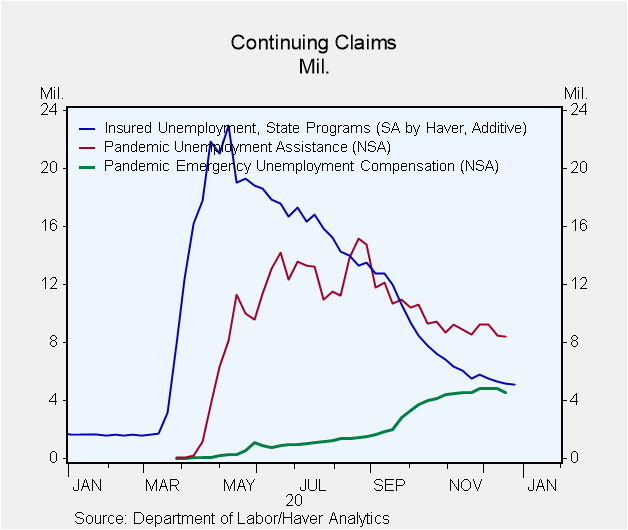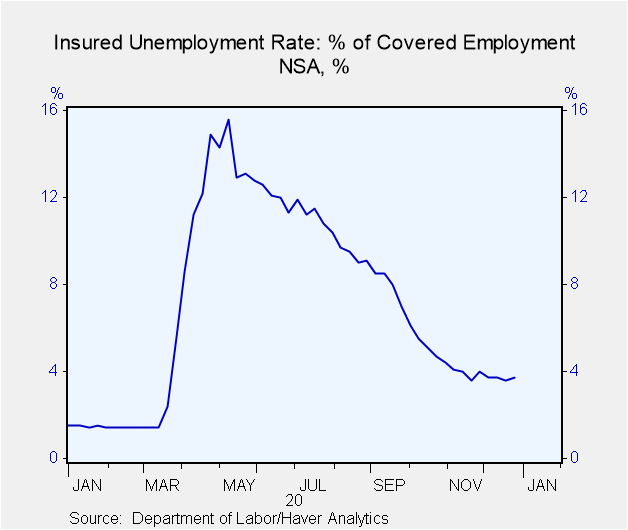 Global| Jan 07 2021
Global| Jan 07 2021U.S. Jobless Claims Decline
Summary
• State initial claims edge lower, third consecutive decrease after reaching a three-month high in mid-December. • Federal Pandemic Unemployment Assistance initial claims drop to lowest since April, early in program's existence. • [...]
• State initial claims edge lower, third consecutive decrease after reaching a three-month high in mid-December.
• Federal Pandemic Unemployment Assistance initial claims drop to lowest since April, early in program's existence.
• State, PUA, and PEUC continuing claims move lower.
• While funding for the federal programs was renewed in late-December, uncertainty about the funding status may have hampered filing.
Seasonally adjusted state initial jobless claims for unemployment insurance edged down to 787,000 in the week ending January 2, from a slightly upwardly-revised 790,000 in the previous week (was 787,000). This is the third consecutive decline after reaching a three-month high in December. The Action Economics Forecast Survey anticipated 772,000 new state claims. A change in the calculation of seasonal adjustment factors created a break in the series in late August. Though the current comparison to September is valid, comparisons to before August 22 are not. Haver Analytics has calculated methodologically-consistent seasonally adjusted claims going back to 1979. This series matches the Department of Labor seasonally adjusted series since the change in methodology. For more details, please see the September 3 commentary on jobless claims.
Claims for the federal Pandemic Unemployment Assistance (PUA) program, which covers individuals such as the self-employed who are not qualified for regular/state unemployment insurance, fell to 161,460 from 310,462. This is the lowest level since April, shortly after the program's initiation. However, comparison to that period is tricky because of backlogs and other difficulties during startup. For more information on this issue, see Measuring employment during COVID-19: challenges and opportunities. Numbers for this and other federal programs are not seasonally adjusted.
Seasonally adjusted state continuing claims for unemployment insurance declined to 5.072 million in the week ending December 26, from 5.198 million. Continuing PUA claims, which are lagged an additional week and not seasonally adjusted, decreased to 8.383 million from 8.453 million. Pandemic Emergency Unemployment Compensation (PEUC) claims moved down to 4.516 million in the week ending December 19. This program covers people who were unemployed before COVID but exhausted their state benefits and are now eligible to receive an additional 13 weeks of unemployment insurance, up to a total of 39 weeks. While funding for the federal programs were renewed in late December, uncertainty about the funding status may have hampered filing.
The seasonally adjusted state insured rate of unemployment held steady at 3.5% in the week ending December 26. This data does not include the federal pandemic assistance programs. If you include the latest data available, which is lagged one additional week, the total number of state, PUA and PEUC continuing claims declined to 18.3 million or 11.4% of the labor force.
The state insured rates of unemployment – which do not include federal programs – continued to show wide variation with South Dakota at just 0.9% and Alaska at 6.4%. The largest states ranged between 1.6% for Florida and 6.0% noted above for California. The state rates are not seasonally adjusted. However, as illustrated in the lower-right hand chart, year-end tends to be a seasonal high period for state continuing claims.
Data on weekly unemployment claims going back to 1967 are contained in Haver's WEEKLY database, and they are summarized monthly in USECON. Data for individual states are in REGIONW. The expectations figure is from the Action Economics Forecast Survey, carried in the AS1REPNA database.
| Unemployment Insurance (SA, 000s) | 01/02/21 | 12/26/20 | 12/19/20 | Y/Y % | 2020 | 2019 | 2018 |
|---|---|---|---|---|---|---|---|
| Initial Claims | 787 | 790 | 806 | 271 | 1,450 | 218 | 221 |
| Initial Claims (NSA) | 922 | 845 | 873 | 175 | 1,367 | 218 | 221 |
| Initial Claims Pandemic Unemployment Assistance (NSA) | 161 | 310 | 393 | -- | -- | -- | -- |
| Continuing Claims | -- | 5,072 | 5,198 | 186 | 10,664 | 1,701 | 1,756 |
| Continuing Claims (NSA) | -- | 5,382 | 5,237 | 151 | 10,358 | 1,704 | 1,763 |
| Continuing Claims Pandemic Unemployment Assistance (SA) | -- | -- | 8,383 | -- | -- | -- | -- |
| Insured Unemployment Rate (%) | -- | 3.5 | 3.5 |
1.2 |
7.3 | 1.2 | 1.2 |
Gerald D. Cohen
AuthorMore in Author Profile »Gerald Cohen provides strategic vision and leadership of the translational economic research and policy initiatives at the Kenan Institute of Private Enterprise.
He has worked in both the public and private sectors focusing on the intersection between financial markets and economic fundamentals. He was a Senior Economist at Haver Analytics from January 2019 to February 2021. During the Obama Administration Gerald was Deputy Assistant Secretary for Macroeconomic Analysis at the U.S. Department of Treasury where he helped formulate and evaluate the impact of policy proposals on the U.S. economy. Prior to Treasury, he co-managed a global macro fund at Ziff Brothers Investments.
Gerald holds a bachelor’s of science from the Massachusetts Institute of Technology and a Ph.D. in Economics from Harvard University and is a contributing author to 30-Second Money as well as a co-author of Political Cycles and the Macroeconomy.









